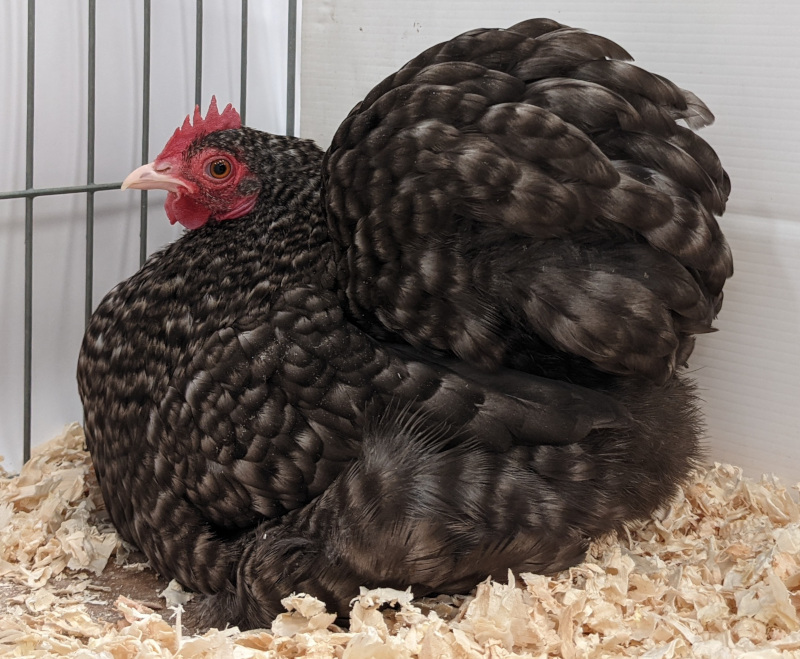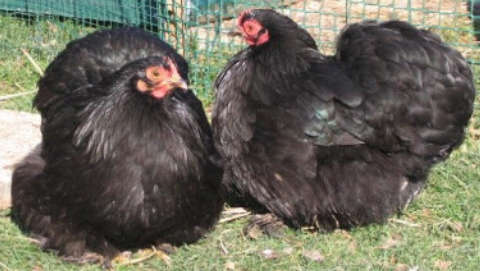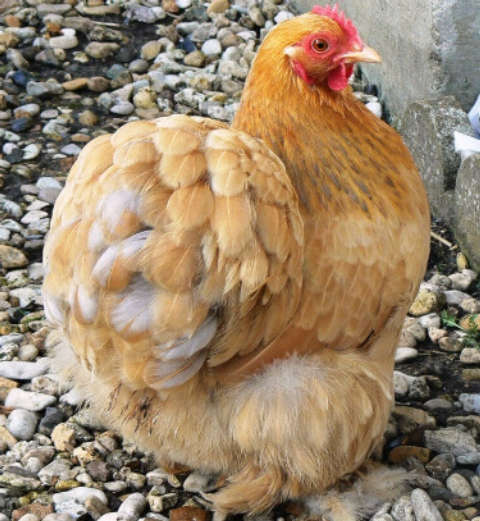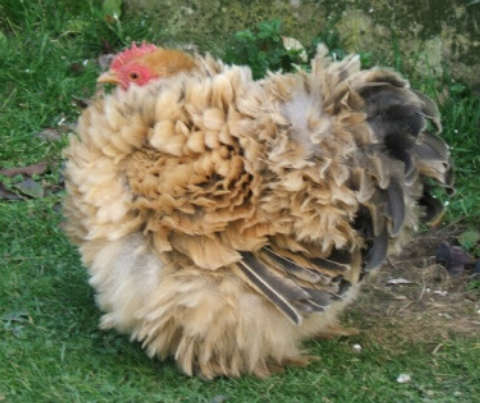Pekin Bantams.

The Pekin bantam chicken is a true bantam with no large fowl counterpart and is well known for it's fluffy, round shape and easy going nature. It is kept almost purely for ornamental or exhibition purposes as it is not much of a layer. The Pekin is a remarkably popular pet chicken, mostly because they are docile and easy to keep.
The hens are regularly broody and are known to be good sitters and attentive mothers. They are not particularly productive egg layers laying between 120 and 160 per year. The Pekin hails originally from China and however you believe it happened it has now spread all over the world.
Below: Ideal Pekin bantams from an old poultry book.

The maximum weight for Pekins is:
Male: 680g and Hen: 570g
Pekin bantam chickens come in a range of colours - Lavender, blue, silver partridge, red partridge, blue mottled, Colombian, cuckoo, mottled, buff, black, white and wheaten.
Pekin Bantam characteristics:
The have short shanks and are small round, fluffy and tilted. The feathers make them look much bigger than they actually are.
Below: A pair of Black Pekins. Notice the sheen on the feathers.

They are rather round-shaped, and their carriage tilts forward, with the head slightly closer to the ground than their elaborate tail feathers. This 'tilt' is a key characteristic of the Pekin. The bird on the whole, though the tail especially, should be abundantly feathered, and well rounded.
The history of Pekin Bantams:
If you research the history of the Pekin Bantam , you will read many stories about their origin. Some say that they were stolen in the 1800’s from a private collection of the Emperor of China, in Peking.
Below: A fully grown Pekin rooster with the beetle green shine on his feathers.

Others say that they were imported as a gift to Queen Victoria the early Victorian era. The birds from those bygone days were then bred, by keepers in the UK, crossed with other breeds of Bantams to create what we now know as the Pekin Bantam.
Some people say that Pekins are known around the world as Miniature Cochins or Cochin Bantams, but it is generally agreed in the UK, by fanciers and keepers, that they are in fact a true Bantam and are not related to or connected to Cochins.
See here for the full history of the Pekin bantam chicken.
Pekin personality:
Pekin Bantams are known and loved by many as one of the most gentle, docile, decorative and fun loving of Bantams. They make excellent and intelligent pets for young children, who delight in watching them hatch and grow and teaching them to come by name.
As layers, they are as good as any other Bantam, laying small, tinted eggs that they are happy to sit on themselves, making them great broody mums for natural incubation. Pekin hens are a delight to have around.
Below: A Pekin hen from the back showing the characteristic "bustle" of feathers.

If you hatch Pekin Bantams yourself and grow them up, you will find that they can become very tame and train very easily, responding exceptionally well to human company.
Even the males can be taught to quieten down and although they can be quite noisy for their size.
At what age do Pekins start laying eggs?
Pekins are not quick to point of lay and it can take 6 to 8 months especially if they are raised late in the year.
Birds that are beginning to mature in the shortening days of fall or Autumn may not begin to lay until the following season and these are no exception. They produce 120 to 160 cream coloured eggs per year for about 4 or 5 years.
How long do Pekin chickens live?
In line with most rare breed chickens they will live on average for between 5 and 7 years. I have several approaching the 10 and 11 year mark but this is around 10 to 15% of birds making it this far. Expect some losses from the age of 3 or 4.
Most chickens have about 4 or 5 productive seasons in them and Pekin are no different.
Pekin Bantam care and keeping:
Size-wise, being so small they are ideal for smaller or more urban or suburban areas, as they require very little space and are happy to be housed in small arcs or coops with attached runs.
Pekins can be introduced to groups of larger Poultry, where they will, over time, accept their place, providing they and your larger birds are initially socialised and supervised.
Unlike the larger breeds, they do not tend to ruin well kept flower beds or churn up lawns and for this reason, make them ideal, easy-keep, low-maintenance pets. They are also suitable to be kept as indoor pets, providing they are allowed adequate space and time to run free on a regular basis. You can even purchase nappies for your indoor Pekins now.
Below: A Frizzle feathered Pekin bantam.

Care must be taken so that the Pekin's foot feathering does not get soiled. Vent feathers may have to be trimmed to maximise fertility when breeding. Frizzle pekins like this one above need even more care and a warmer more sheltered environment than the standard bird.
If you want to keep Pekins to show, it is best to find out how to properly care for and house your birds from an experienced breeder first. There are minimum suggested housing sizes that you can read about on the RSPCA website, however those who show poultry often keep their Pekin show birds in box-like 2’ x 2’ hutches, which can have both advantages and disadvantages.
Pekin bantam chicken breed standards.
Do consider their well being as well as why you are keeping them and what you hope to gain from keeping them and you will soon find that they become a life long passion.
Health-wise Pekins are generally strong, robust little Bantams, only suffering from the typical poultry conditions if exposed to the causes environmentally. They do however, need extra care to be taken regarding their flooring materials and you will need to be careful where you let them run, because of their low carriage and feathery legs and feet.
If the weather is bad, you cannot keep Pekins on muddy or sodden ground, otherwise you run the risk of causing them great suffering. They must be kept on dry, clean bedding at all times.
Do Pekin Bantams fly?
Pekin bantams can fly, although not well and will need their wings clipping to avoid them escaping, as they can jump and fly quite high, even over 6 foot fences!
As long as they are happy in their surroundings then they generally choose to stay on the ground.
Colours and feathering:
Pekins are becoming more and more popular, both in the UK and abroad and are bred and available in a whole range of beautiful colours. This list includes lavender, lemon, gold partridge, blue, silver partridge, red partridge, blue mottled, Colombian, cuckoo, barred, mottled, buff, black, black mottled, white, mille fleur, porcelain and wheaten.
They can have straight (normal) feathering or frizzle feathering, which means that the feathers grow the opposite way round and stick out rather than running smooth, giving them a ‘fluffy’ appearance.
All types of Pekins have short, feathered legs and feather covered feet and toes. The hens have a rounded full and bushy tail called a ‘bustle’ which gives them the ‘Persian cat’ rounded, puffed up appearance.
The abundance of feathering does give the Pekin the appearance of being larger and heavier than they actually are, but their average weight is only 680g (24oz) for males and 570g (20oz) for females.
The full range range of Pekin colours and feather patterns is extensive, and the list is continually growing. Colours include black, blue, buff, cuckoo, mottled, barred, Colombian, lavender, partridge, white, birchen, and silver partridge.
Rarer colours are in great demand, and many breeders spend much time perfecting new lines of colours in their birds. Frizzled Pekins are common.
Looking after Pekin Bantam chicks:
Pekin chicks are hardy and will thrive on ordinary chick feed from the earliest stages. Avoid feeding mash during the growing period since it very often results in sour crop.
Pekin chicks should be kept in until it has dried. More Pekins die as a result of dampness than any other cause.
The chicks are handicapped in the direction through possessing to much foot feathering. Once the foot feathering gets wet, it takes a considerable amount of time for it to dry.
The chicks receive as much as they can eat. When feed is made available from the beginning it will be found that the chicks eat a little at a time, whereas hungry chicks overload their crops.
Finely cut spinach fed two or three times weekly until they are weaned onto growers ration.
